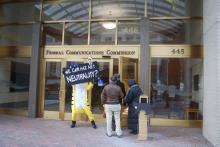
For decades U.S. broadband policymaking has been plagued by inaccurate and badly-managed data that has significantly harmed efforts to not just track U.S. broadband deployment, but ensure that billions in taxpayer dollars are being wisely spent to address the problem.
From inaccurate broadband mapping data and an over-reliability on industry-provided coverage claims, to inconsistent broadband definitions and patchwork federal oversight, a new study by the Pew Charitable Trusts examined decades of U.S. broadband policy, and data analysis and found plenty of room for improvement.

According to a 2022 Government Accountability Office (GAO) report, there have been 133 programs across 15 federal agencies supporting and funding U.S. broadband deployment efforts, propped up by more than $44 billion in taxpayer dollars from 2015 to 2020 alone.
ILSR studies have historically shown those funds haven’t always been spent wisely; often being dumped into the laps of the very same regional telecom monopolies whose attacks on competition and government oversight resulted in substandard access in the first place.
There’s billions more waiting in the wings: as part of the 2021 American Rescue Plan Act (ARPA), $25 billion was specifically earmarked for broadband expansion.
Another $45.2 billion was earmarked for broadband expansion as part of the 2021 Infrastructure Investment and Jobs Act (IIJA); funding many states are still waiting for.
Governments Need To Do Better
Pew’s analysis of U.S. broadband data collection found numerous areas of concern that have been repeatedly brought up by researchers over the last few decades. For example, much of the federal broadband data on broadband access, adoption, and household characteristics is often reported by county, ZIP code, or census tract, rather than by household.

Until recently with the passage of the bipartisan infrastructure law, agencies like the Federal Communications Commission (FCC) determined an entire census block “served” with broadband if just one home in the census block had broadband.
Pew found that other geographic and household characteristics—such as the regions used in data collection or the composition of households—are not standardized across researchers and government, making it difficult to combine datasets for evaluation.
“This lack of standardization has led to inaccuracies in measuring the impact of broadband and the gaps in coverage, which is particularly problematic for federally funded projects that rely on accurate mapping data for broadband investment,” Pew wrote.
Other areas of concern include widespread state and federal over-reliance on industry-reported broadband coverage and speeds, often overstated by large regional telecom monopolies to obscure market failure and local broadband competition shortcomings.
Federal data often refuses to integrate broadband prices, another policy favoring large regional telecom monopolies keen to downplay the impact consolidation, monopolization, and a lack of competent regulatory oversight have on real-world broadband affordability and access.
Failing At The Very Basics
Pew also acknowledged that the federal government has been consistently inconsistent at very basic concepts, such as a uniform definition of what constitutes “broadband.”
The FCC only last year updated the federal definition of broadband to a meager 100 Mbps downstream/20 Mbps upstream after a decade of criticism from the GAO and others.

Here too, a slow speed definition favors large dominant telecoms looking to obscure failures in reasonable and timely deployment of reliable, affordable broadband.
A 2023 GAO study looking at the FCC’s older speed definitions found that not only had the FCC historically set the definitional bar abnormally low, it failed to transparently document how it was making its determinations.
“Despite the significance of the benchmark, FCC’s reporting of the analysis and data it considers when assessing whether to raise the speed benchmark has been inconsistent and therefore falls short of FCC’s goal of having a transparent process,” the GAO said.
Pew found that U.S. data sources were also inconsistent in defining other key components necessary for effectively tracking broadband upgrades and improvements, including varying and vague definitions of terms like “digital equity” and “digital literacy.”
“The available data makes it difficult to determine the availability of affordable broadband connections or how to define affordability, and there is no uniform method of tracking broadband adoption patterns over time,” Pew found.
Minor Improvements But Plenty Of Work To Be Done
Pew acknowledges there are areas where government broadband data analysis has improved somewhat in recent years. The Biden FCC made some useful improvements to broadband mapping as mandated by Congress in the IIJA, though ample criticisms remain (particularly related to the fact this data is non-transparently owned by a private company, not the public).
Pew notes progress in other areas, ranging from the Biden National Telecommunications and Information Administration’s (NTIA) increased prioritization of affordability in data analysis, to the FCC’s adoption of a “nutrition label” for broadband, requiring that telecom providers more clearly advertise a connection’s price, speed, and limitation.
At the same time, many of these recent improvements are being undermined by a Trump administration that’s taken aim at FCC oversight authority, dismantled popular efforts to prevent digital discrimination, and embraced legislation and policies that will dramatically reduce affordability and increase the financial burden on numerous U.S. households.
Pew’s analysis omits mentioning that improving many of the methodologies and metrics under an administration that does not believe in equity, regulatory oversight, or at times informed, reality-based consensus, poses significant new obstacles for meaningful and lasting reform.

Pew found that failing to implement reforms on data collection and analysis has numerous negative real-world impacts, including the potential misallocation of what could be an historic flood of taxpayer subsidies.
Illogical and ever-shifting definitions of terms like “served,” and collisions between numerous conflicting program definitions have already caused problems. What often impacts these shifting definitions most isn’t innocent policymaker mistakes, but intentional efforts by entrenched telecom giants to box municipalities and competitors out of federal grants.
Unreliable and often outdated information, inconsistent definitions, and often conflicting federal strategies make it difficult for federal and state governments alike to accurately track taxpayer subsidies, opening the door to increased subsidy fraud.
“The absence of a national broadband strategy has led to a fragmentation of federal broadband programs—hindering efforts to prevent waste, fraud, and abuse, and limiting the federal government’s ability to reduce program overlap and duplication of effort,” Pew notes.
Many of the problems in data tracking and analysis were made more evident by the infrastructure bill’s Broadband Equity Access And Deployment (BEAD) program. And many more will be made evident as states try to adhere to revamped BEAD program requirements.
“Shortcomings in federal data suggest that more could be done at the federal level to equip implementation and evaluation efforts,” Pew politely notes. “By providing the tools needed to evaluate the relationship between connectivity and socioeconomic outcomes, policymakers could build broader consensus across government and industry on the importance of sustained investments in broadband.”
Header image of FCC map courtesy of FCC website
Inline image of See Speak or Hear No Evil monkey statue courtesy of Japanexperterna.se on Flickr, Creative Commons, Attribution-ShareAlike 2.0 Generic
Inline image of FCC front entrance courtesy of Rob Pegoraro on Flickr, Creative Commons, Attribution-NonCommercial-ShareAlike 2.0 Generic
Inline image of little girl distressed over bad Internet connection courtesy of eviemaedavid on Flickr, Creative Commons, Attribution-NonCommercial-NoDerivs 2.0 Generic







